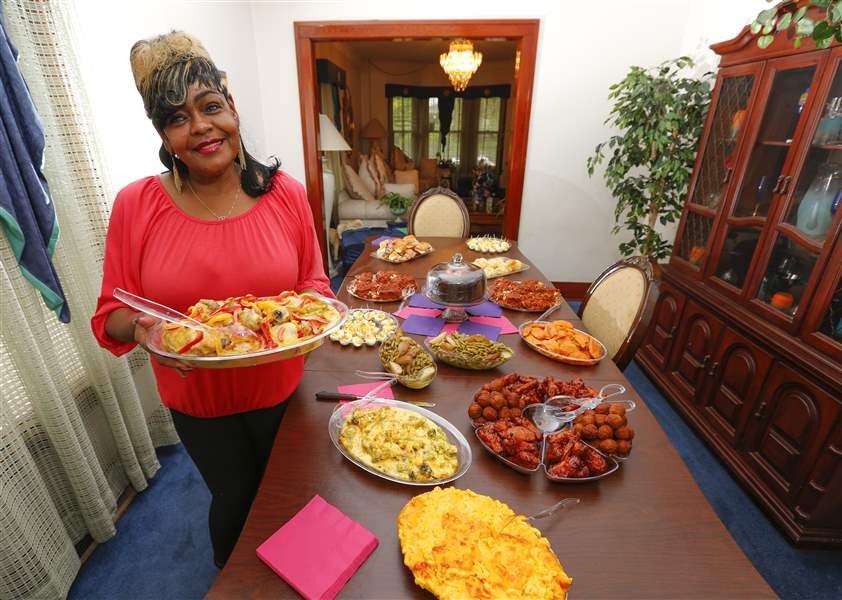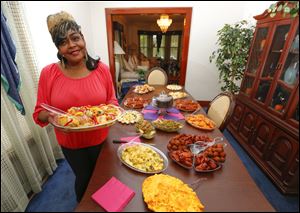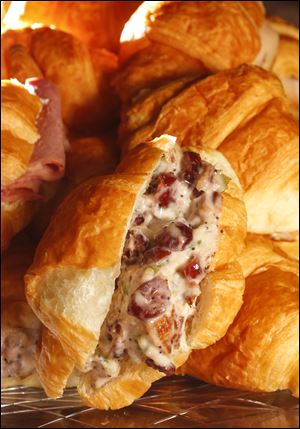
Food helps build trust, security for children in foster care
8/3/2014
Theresa Jelks holds her Tas-Tee chicken at her Toledo home.
The Blade/Andy Morrison
Buy This Image

Theresa Jelks holds her Tas-Tee chicken at her Toledo home.
For children in foster care, food is much more than nutrition and health.
Food also means love and security.
“Sometimes, the only thing that was loyal to them was food,” says Robin Reese, placement and department manager at Lucas County Children Services, of the relationship that some children in foster care have with food and with the situations that ultimately led them into protective custody.
Other concerns can include untreated diabetes or allergies, poor dental hygiene, even squirreling food away and hiding it for later. Foster care families are advised by the agency to always keep some items — such as fruit and other snacks — visible and accessible so that the children develop a trust that there will be a stable food supply.
“Most of our kids, when they come into care, they have food issues ... mostly lack thereof,” Ms. Reese says. But “when they feel safe, the hoarding will go away.”
Julie Malkin, public information officer for Lucas County Children Services, agrees that foster care families can “use food sort of as an anchor.”
Two women who do this particularly well are Theresa Jelks and Maggie Lawrence, both of whom have been foster mothers for more than 20 years.
Mrs. Lawrence (fondly known to many as “Miss Maggie”) doesn’t just make sure that the young men in her care are full at mealtimes. “I do over-full,” she says. “I don’t cook by a recipe and I have never cooked a small amount.”
After raising eight children of her own, three of Mrs. Lawrence’s grandsons became her first wards. She adopted them “before they got into the system,” and they are now in college. She is proud that they have grown up to be “church-going young men, Bible-carrying young men.”
She has opened her home to 10 children over the years, many of whom have had special needs. “I think [it’s] my calling,” says Mrs. Lawrence. Several of the boys who have been in her care have been diagnosed with autism.
Most recently, a young man named Michael has come to stay with Mrs. Lawrence. “Michael is nonverbal, but he understands,” she says. She had thought it was time to retire from foster care, not accepting any new wards, until she found out that Michael “had been neglected really, really bad.” She couldn’t turn him away, she says. “I’m all he got.” When he arrived at her house, Michael was a picky eater. But, Mrs. Lawrence says, “I make him drink water, not pop,” and she wants him “to eat healthy.” He now enjoys everything from pizza to chicken and turkey breasts, and particularly likes the beverages — “even with spinach” — that Mrs. Lawrence’s grandsons make with a juicer.
Another of her wards with special needs is Joey, “a loving young man,” as she describes him, who works as a busser and saved up to buy his own computer. When he came to her at age 16, all Joey liked was chicken nuggets. He had been living with his grandmother, who “had mental issues,” Mrs. Lawrence says, in a house that had no running water. He would go to a nearby McDonald’s to eat when no other food was provided.
“He loves what I cook from scratch,” Mrs. Lawrence says. “He likes meatloaf ... oh, he loves the chicken.” But she says he doesn’t like sweets, even though one of his responsibilities at work is to help with baking cookies.
Ms. Jelks, too, encourages healthy eating habits. She finds that “kids in care don’t like vegetables,” so she tries to incorporate them into other foods.
A number of the children who’ve been in her care require special diets, so Ms. Jelks is well-versed in discussing such health concerns as elevated blood sugar levels and the diabetes drug Metformin. Having a secure and nutritious food supply is an essential part of medical care. She, like Mrs. Lawrence, doesn’t permit carbonated drinks for those in her home, where she is caring for three girls ranging in age from 7 to 18 and a son whom she adopted.

Cranberry pecan chicken salad on a plate with turkey, ham and corned beef sandwiches at the home of Theresa Jelks,
A caterer who used to own the Tas-Tee Empact restaurant, Ms. Jelks has been told by her family, “We think you’re like Jesus Christ, how he took those two fishes” and multiplied them to feed the 5,000. When talking about an item as simple as mashed potatoes, her passion for cooking is obvious. She prepares the dish with “lots of real butter, lots of real cream, and lots of love.”
Ms. Jelks discovered her talent for cooking when she attended Macomber-Whitney vocational school. An instinctive cook, she says, “I would take their recipes and critique them and make them better.” Her mother would wake up in the middle of the night and find Ms. Jelks cooking and baking still, beyond what was required for school.
She became a foster mother in 1993 and since then has cared for about 300 children, many of whom, Ms. Reese says, are among “the toughest kids,” including some who have been freed from sex trafficking. Because she lives near the Rescue Mental Health Services facility, Ms. Jelks can often be called in the middle of the night for emergency situations, too.
“It’s always nice to offer them a warm meal,” she says, when children first arrive at her home, as this encourages them to open up a bit about what’s brought them into foster care. She likes to ask about the children’s favorite foods, and tries to serve these to assist in the transition period. Sitting down together, with food acting as a comforting intermediary, can help to break down barriers.
Ms. Jelks doesn’t force the children in her care to eat foods they don’t like, and tries to have something available to suit each child’s tastes and needs. She doesn’t want to turn mealtimes into a battleground, and knows that it is critical for her wards to trust her as an ally.
Families who open their homes and their hearts to foster children are truly saving lives. “These are the real warriors in the fight against child abuse,” says Ms. Reese.
Through love and safety and an abundance of nutritious and comforting food, Mrs. Lawrence and Ms. Jelks have offered so many a refuge from abuse and neglect.
“When they walk through the door, they’re part of my family,” Mrs. Lawrence says. “I love taking care of God’s kids.”
Ms. Jelks echoes that statement: “Once you’re Mom, you’re always Mom.” She makes sure to tell the children in her care, ”I’ll be in your life as long as you need me.”
Lucas County Children Services is looking for foster families for children of all ages, particularly infants and young children. The agency offers free information and training classes at its offices at 705 Adams St. in downtown Toledo. Classes are Tuesday and Thursday evenings, Sept. 2 through Oct. 9, from 6 to 9, as well as on Saturdays, Sept. 20 through Oct. 25 from 9 a.m. to 4 p.m. (two classes each day). To register, call 419-213-3336 or visit www.lucaskids.net.
Contact Mary Bilyeu at: mbilyeu@theblade.com or 419-724-6155.
Miss Maggie’s Macaroni and Cheese
1 soup spoon olive oil
1 tablespoon salt + more to taste
1 pound macaroni
4 cups milk
1½ pounds + 3 cups shredded mild cheddar cheese
½ cup flour
Pepper, to taste
Preheat oven to 350F. Coat a 9”x13” baking pan with nonstick spray.
In a stockpot, bring water to a boil with the oil and 1 tablespoon salt. Cook the macaroni for 10 minutes, then drain.
Meanwhile, heat the milk in a large saucepan. Gradually add the 1½ pounds of cheese, whisking with each addition to incorporate the cheese before adding more. Once the cheese has melted, whisk in the flour, as well as some salt and pepper to taste, until smooth.
In the prepared pan, layer half the macaroni topped with half of the remaining cheese; pour half the sauce over the top and spread over the macaroni. Repeat with the macaroni and the last of the cheese, then pour the remaining cheese sauce over everything and smooth the sauce to the edges of the pan so it can seep down into the crevices. Place the baking pan onto a larger baking sheet, to catch any drips.
Bake for 45-50 minutes, until golden brown. Let rest for 10 minutes before serving.
Cook’s Note: The macaroni and cheese can be covered and frozen before baking, then thawed and cooked when needed.
Source: Adapted from Maggie Lawrence